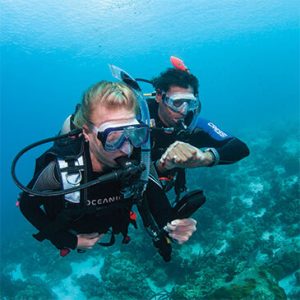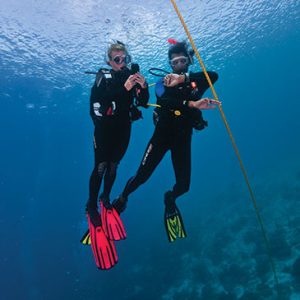Lesson 137
Learning Objectives
By the end of this session, I should be able to answer these questions:
1. What are the signs and symptoms of gas narcosis?
2. What potential hazard does gas narcosis present?
3. Generally, what causes gas narcosis?
4. At what depth do most divers usually begin to notice gas narcosis?
5. What factors may influence susceptibility to gas narcosis?
6. How do I avoid gas narcosis? What do I do if it occurs?
Gas Narcosis
Section Four discussed contaminated air, oxygen toxicity and decompression sickness. The fourth issue related to the component gases in air is gas narcosis.
Many gases, including oxygen and nitrogen, cause an intoxicating effect under pressure. This is called gas narcosis. Signs and symptoms may include:
- Feeling intoxicated (drunk or “high”)
- Loss of coordination
- Slowed thinking
- Slowed reactions
- Inappropriate laughter
- Depression
- False sense of security
- Ignoring or disregard for safety
- Anxiety and/or panic (when under stress at depth)
Gas narcosis is not thought to be harmful itself. The hazard is that it impairs the good judgment, clear thinking and timely responses you need to avoid and manage problems underwater.
At one time, it was thought that narcosis was only caused by nitrogen, and it was common to call gas narcosis nitrogen narcosis. Today, it is known that oxygen is similarly narcotic (hence, EANx doesn’t have a gas narcosis advantage). However, some gases – such as helium – are not narcotic, and tec divers breathe gas mixes with helium, which helps manage narcosis. This is beyond the scope of, and not necessary for, recreational diving.

Cause and Effects
Gas narcosis is thought to be caused by increased dissolved gases in body tissues slowing nerve impulses that travel in the brain and nervous system. It slows the communication between the brain and the body, and between different parts of the brain.

Breathing air (or EANx), most divers begin to notice narcosis at approximately 30 metres/100 feet. Narcosis differs, however, from individual to individual and in the same diver from one dive to the next. Being tired, dehydrated or generally fatigued may make narcosis noticeable shallower, and some prescription and over-the-counter drugs combine their effects with narcosis, making intoxication stronger (this is another reason why you don’t use alcohol and certain drugs before diving).
Cool water, darkness and limited visibility seem to increase narcosis, though it may be that added stress simply makes the effects more noticeable. Diving experience seems to reduce narcosis – but physiologists think that you learn to compensate for it.
Avoiding and Managing Gas Narcosis
You avoid gas narcosis by not diving too deep. For most people, assuming no predisposing factors, gas narcosis isn’t likely to be a concern diving as deep as 30 metres/100 feet (as a new PADI Open Water Diver, you’re qualified to a maximum of 18 metres/60 feet). Recreational divers with further training and experience can qualify to dive as deep as 40 metres/130 feet (the maximum depth for recreational diving). One of the benefits of the PADI Deep Diver course is that you learn more about narcosis and are provided the opportunity to experience it under instructor supervision.

If you experience narcosis, immediately ascend to a shallower depth. Continue the dive at a shallower depth, or abort the dive. Narcosis generally fades quickly when you return to a shallower depth. If your buddy appears or acts “narked,” guide your buddy to a shallower depth.
knowledge review and quiz
Comments

I'll take you diving!
Copyright © Larry Wedgewood Scuba Instruction All Rights Reserved















